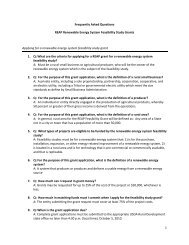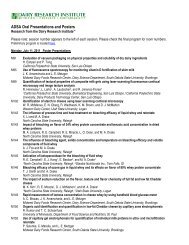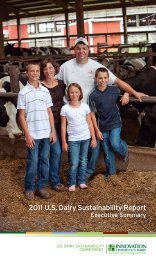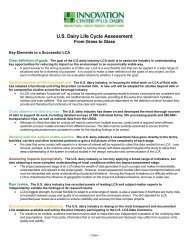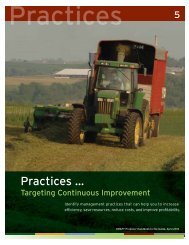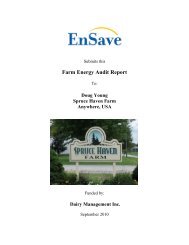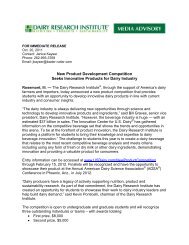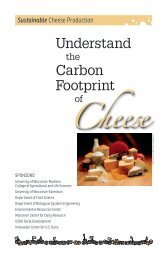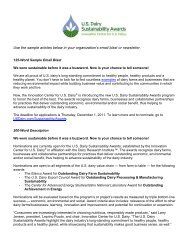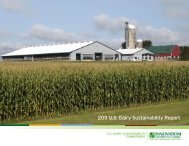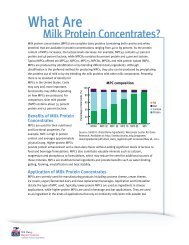Processor Handbook - Innovation Center for US Dairy
Processor Handbook - Innovation Center for US Dairy
Processor Handbook - Innovation Center for US Dairy
Create successful ePaper yourself
Turn your PDF publications into a flip-book with our unique Google optimized e-Paper software.
kg CO 2<br />
e per kilogram (kg) milk consumed). 7 In 2007, the<br />
cumulative total emissions of GHG emissions associated<br />
with the consumption of fluid milk in the U.S. were 35<br />
teragrams (Tg) CO 2<br />
e. This represents approximately two<br />
percent of the total U.S. GHG emissions. 8<br />
To meet the needs of the marketplace, the U.S. dairy<br />
industry, under the leadership of the <strong>Innovation</strong> <strong>Center</strong>,<br />
endorsed a voluntary goal to reduce GHG emissions <strong>for</strong> fluid<br />
milk by 25 percent by 2020. 9<br />
The indicators in the Guide focus on the emissions released<br />
at various stages of the dairy value chain. For each indicator,<br />
the boundary and scope of the emissions is indicated.<br />
3. Water<br />
Globally, approximately 70 percent of the world’s<br />
freshwater withdrawals are <strong>for</strong> agricultural use (crop<br />
irrigation, livestock, etc.). 10 Furthermore, total water use<br />
<strong>for</strong> agriculture is expected to increase 13 percent by 2050. 11<br />
As a result, water management has become a key issue <strong>for</strong><br />
food companies. 12<br />
Water impacts along the dairy value chain are twofold: 1)<br />
water supply and 2) water quality.<br />
Water supply<br />
Water is an important resource used throughout the dairy<br />
supply chain. Across the dairy value chain, up to 90 percent<br />
of the water consumed is a result of crop irrigation. The<br />
remaining 10 percent is used during other stages of the<br />
dairy supply chain including milk production (cleaning<br />
of milking parlor, cooling of milk and providing drinking<br />
water <strong>for</strong> cows), fluid milk processing and dairy product<br />
manufacturing (cleaning of the processing pipes, equipment<br />
and trucks).<br />
The availability of water differs throughout the United<br />
States. Challenges related to availability of water are a<br />
regional issue because water users are confined to local<br />
watersheds. In areas where water becomes scarcer, good<br />
water management becomes increasingly important <strong>for</strong> the<br />
dairy industry and other users of water in those areas.<br />
Phase 1 PM Indicators include water use and efficiency.<br />
In addition to the effect on water sources, dairy companies<br />
could identify the impact of the products they purchase on<br />
water sources in other regions of the country.<br />
Water recycling is one of several strategies that can be<br />
used by processors to reduce their impact on stressed<br />
water bodies.<br />
Water quality<br />
Through their various activities, dairy processing and<br />
manufacturing facilities have an impact on the quality of<br />
water sources, which could be immediate in their local area<br />
as well as farther away.<br />
<strong>Dairy</strong> processing facilities and manufacturing plants<br />
discharge wastewater that has been treated, which could<br />
be applied in the <strong>for</strong>m of sludge on the land as fertilizer,<br />
discharged into local water bodies or sent to local<br />
wastewater treatment plants.<br />
The Guide includes water quality indicators <strong>for</strong> processors<br />
and manufacturers.<br />
2<br />
Primary Sources of Greenhouse Gas Emissions <strong>for</strong> Fluid Milk in the U.S.<br />
Carbon footprint = 17.6 lbs. CO 2<br />
e per gallon of fluid milk<br />
lbs. CO 2<br />
e / gallon<br />
5.0<br />
4.5<br />
4.0<br />
3.5<br />
3.0<br />
2.5<br />
2.0<br />
1.5<br />
4.42<br />
4.02<br />
3.33<br />
3.15<br />
1.38<br />
Supply Chain Contribution<br />
Feed Production<br />
Milk Production<br />
Processing<br />
Packaging<br />
Transportation/Distribution<br />
Retail<br />
Consumer<br />
1.0<br />
0.5<br />
0.67<br />
0.41<br />
0.0<br />
Enteric<br />
Manure<br />
Management<br />
Fuel<br />
Electricity<br />
Feed<br />
Production<br />
Refrigerant Packaging<br />
Sources related to waste are not included.<br />
Source: Gregory D. Miller and Ying Wang (Eds.), Carbon and Water Footprint of U.S. Milk, From Farm to Table,<br />
Special Issue. Int <strong>Dairy</strong> J. April 2013; 31(Supplement 1), S1-S100<br />
Available at <strong>US</strong><strong>Dairy</strong>.com/Sustainability<br />
Figure 1. Primary Sources of Greenhouse Gas Emissions <strong>for</strong> U.S. Fluid Milk<br />
11





